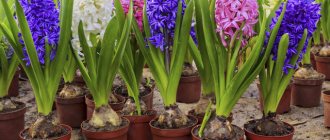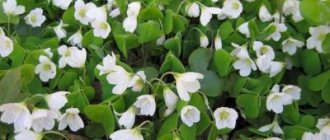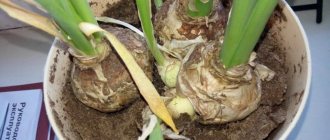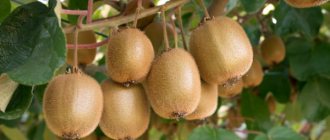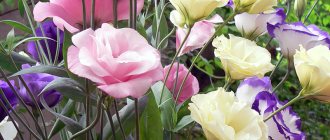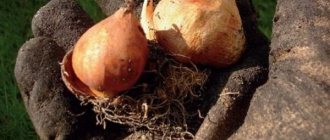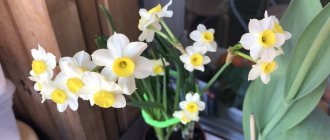Hyacinth is a garden flower, but it is also successfully grown in pots. Hyacinth in a pot is a bright decorative flower that appears in stores on the eve of the winter and spring holidays. Manufacturers often advise treating such a plant as a living bouquet. That is, just throw away the bulb after flowering. However, this is not the only option.
We will talk about planting and caring for hyacinth in a pot at home and how to preserve the bulb in order to achieve repeated flowering next year.
Characteristics of hyacinth
Hyacinth is a herbaceous bulbous perennial from the Asparagus family. Grows from 20 to 40 cm. The leaves are succulent, linear - from 4 to 8 pieces in a basal rosette. The buds are collected in a cluster (sultan) on a fleshy, thick peduncle. The flowers look like bells. As they open, the petals arch. The bulb can be round or cone-shaped - the average diameter is about 6 cm. The color of future flowers is determined by the color of the outer scales:
- purple bulb - blue, violet or blue flowers;
- lilac - pink, crimson, light gray;
- brown - yellow, beige, peach, scarlet, orange.
Regardless of where hyacinth grows - at home in a pot or in a garden - it blooms once per season, for 10-14 days. With good care and optimal conditions - up to 25 days.
Three stages of hyacinth development
The development cycle of hyacinth throughout the year can be divided into three periods:
- Spring growing season (lasts 3 months) - appearance of leaves, flowering, formation of daughter bulbs.
- Summer dormancy (3 months) - begins after the leaves dry out; during this period the bulb should be at a temperature of about 25 ° C.
- Winter dormancy (6 months) - lasts from mid-autumn until spring leaf growth.
All three periods are necessary for the development of a bulbous plant. Moreover, they can be created artificially, achieving flowering of hyacinth at unusual times. The technology of forcing flowering is called forcing. It is these forced hyacinths that we buy in pots in winter and early spring.
How to care for home hyacinth after purchase
So, you brought a plant from the store. What to do next?
You need to care for hyacinth at home in such a way as to recreate its existence in nature as accurately as possible. This is not to say that the flower is too capricious, but it is still necessary to comply with simple requirements when growing it.
Caring for a blooming hyacinth in a pot comes down to the correct choice of placement, timely watering and fertilizing
Do you need a transplant?
The flower from the store sits in a small pot, and the bulb protrudes a third from the ground. There is no need to transplant into a spacious container. He's not cramped. During flowering, it feeds from the bulb, so the volume of the container does not matter. And replanting will cause stress and shorten the flowering time.
Lighting
The plant is placed in the brightest place without drafts, otherwise it will quickly wither. In February and March, you can arrange additional lighting, and in May, protect it from direct sunlight. The flower needs evenly diffused light.
Temperature
The optimal temperature for blooming hyacinth is 15-20°C. Coolness prolongs its flowering. Heat, on the contrary, can have a detrimental effect, so it is better to keep it away from a hot battery.
Air humidity
Hyacinth in a pot is not too susceptible to fluctuations in humidity; you definitely shouldn’t spray it. However, excessively dry air (for example, near a hot radiator) can lead to blackening of the tips of the leaves and drying out of some of the flower buds.
Watering and fertilizing
The plant is watered along the edges of the pot so that water does not fall on the bulb and in the center of the rosette. If the bulb is large and the soil is almost invisible, then it is better to pour a little water into the pan.
Water the hyacinth carefully, without creating a swamp in the pot, as stagnation of moisture will cause the bulb to rot. Water at room temperature. The ideal option is warm melt or rain water.
Once every two weeks, indoor hyacinth is fed with universal liquid fertilizer for bulbous flowers. The dosage is in the instructions for the drug. The nutrient solution is applied to moist soil.
The video will tell you how to care for hyacinth in a pot after purchase:
Hyacinth in a pot has faded: what to do next
Let us remind you that in the store we are usually offered forced hyacinths in pots. When forcing, producers shorten the natural vegetative cycle of plants. This depletes the hyacinth bulbs so much that sellers often advise not to do anything with them after flowering - just throw them away. But even potted hyacinth is a perennial, which means the bulb can be preserved until the new season and achieve repeated flowering in spring.
To do this you need to do the following:
- When the flowers wither, the upper part of the peduncle is immediately removed so that a segment of 10-15 cm remains. This will prevent the ripening of the seeds and, accordingly, the outflow of nutrients from the bulb to the inflorescence. There is no need to cut off the leaves.
After the hyacinth has faded, it is necessary to trim the peduncle - After trimming part of the peduncle, the plant is transferred along with the soil into a larger pot or planted in open ground without deepening the root collar. Such a transplant is necessary for the bulb to recover after flowering, stock up on nutrients, grow and form “children.” If you leave it in a small pot with almost no soil, it will not receive proper nutrition. This means flowering next year will be a big question mark. For replanting home hyacinth, the following is suitable:
- universal primer, which is diluted 30% with sand
a mixture of garden soil, sand, humus and peat in equal proportions.
- After transplanting, water moderately and wait until the soil dries. After a week, feed with complex fertilizer for bulbous flowers and again after another 10 days. During this time, the bulb will grow, gain strength and weight.
- By mid-May, the leaves will begin to yellow and die. At this time, watering is stopped. Gradually, the green part of the plant will dry out completely. Dry wood is cut off.
A layer of drainage (1-2 cm) must be placed at the bottom of the pot.
What to look for when purchasing
Of course, if you were given a plant, then where can you go - we work with what we have. But if you bought it yourself in a store, then in order for the hyacinth to delight you with its beauty on the windowsill for a long time, you need to pay attention to the following points:
- The bulb must be whole, dense, without rot or damage.
- Leaves are whole, without yellowing, elastic.
- The inflorescence is in the budding phase, dense and fresh. It should rise above the leaves.
- Roots should not protrude from the drainage hole; dark color indicates the beginning of root rot. You can check this simply - ask the seller to remove the bulb from the pot, usually this is very easy to do, and check the root system.
Digging and storing hyacinth bulbs
Next, the bulbs are dug out of the ground and sent for summer storage - for 2.5-3 months.
Work order step by step:
- The bulbs are carefully removed and cleaned from the soil. The roots and loose scales are removed. If there are small onions (babies) on the mother bulb, they are separated and also sent for storage. Afterwards, they are grown for 2-3 years in exhaust gas to an adult size; they are too small for flowering.
- The dug up bulbs are washed and disinfected in a warm, deep pink solution of potassium permanganate or in Maxim for 30-40 minutes.
- After cleaning, the bulbs are dried for 5-7 days in a dark place with good ventilation, at a temperature of 18-20°C. Humidity is average – 45-60%.
- Next, the bulbs are placed in paper bags and stored in a dark place at a temperature of 25-30°C. Exposure time - 1 month.
- Then the storage temperature is reduced to 17-20°C. They are kept in such conditions until planting in the ground - on average, until mid-October.
Hyacinth bulbs are stored in paper bags, wrapped in newspaper, in cardboard boxes or boxes.
Please note!
Planting material is not stored in the refrigerator or in plastic bags.
Planting hyacinth bulbs in open ground
After the summer storage period has passed, the forcing hyacinth bulbs are best planted in the wild - in the OG. This is the best case scenario: the bulbs in the ground will gain strength, recover and will definitely bloom next spring.
Hyacinths are planted in open ground before winter - 3-4 weeks before the first frost (the same as when planting tulips in the fall). Taking into account different weather conditions - in early to mid-October. The time is chosen so that the bulbs have time to take root, but do not sprout. The optimal soil temperature is 8-10°C.
Planting bulbs in exhaust gas is the best solution for potted hyacinths after flowering
Work order:
- The bed is prepared in advance. The earth is dug up to a depth of 30-40 cm.
- The soil is fertilized with compost or humus (1.5 buckets per sq.m.).
- The optimal soil acidity is 6.5 pH.
- Before planting, the bed is loosened, leveled and holes are formed.
- The hole should be 4 times deeper than the height of the bulb. For heavy soil, the depth is reduced by 2 cm, and for light soil, it is increased by 2 cm. The distance between holes is up to 10 cm.
- 3-5 cm of sand is poured into the bottom of the planting hole. The bulb is placed bottom down (no need to press it in), covered with sand and earth on top. Sand reduces the likelihood of rotting.
- The bed is moderately watered and mulched with peat, rotted sawdust or dry leaves in a layer of 7-10 cm.
- In spring, the mulch is removed after the snow melts.
- With the appearance of the first shoots, feed with nitrogen fertilizer once every two weeks.
- When the hyacinths bloom, apply potassium fertilizer.
Maintenance is standard: maintain light soil moisture, remove weeds and loosen once a week.
Why is this necessary?
Hyacinth needs a transplant in two cases.
After purchasing a potted plant . Hyacinths intended for forcing are kept in a special “transport” low-nutrient but loose soil that retains moisture for a long time.
The plant blooms due to the nutrients accumulated in the bulb.
To preserve such a hyacinth after flowering, the bulb is transplanted into a fertile substrate, giving it the opportunity to recover and produce offspring. If this is not done, the flower will die.
After the foliage of garden plants wilts . For full flowering, bulbous primroses need to provide a period of rest, during which the bulbs will be at a constant temperature of +18 +22 degrees and low humidity. This period lasts 60 - 80 days. In a temperate climate, such conditions can only be ensured by digging flowers out of the soil.
An alternative option is to plant the bulbs back into the pot (forcing)
If it is not possible to identify a hyacinth bulb in a garden flower garden, it can be sprouted at home. This will essentially be a re-forcing. Most likely, this secondary flowering will be weaker than the first.
Therefore, it is better to purchase new healthy bulbs for forcing. In the fall, stores sell a lot of planting material with the note “ready for forcing.” Buy them. You can also use your own bulbs grown in exhaust gas, but you need to be careful in choosing them.
Hyacinth bulbs for forcing should be:
- large – at least 5 cm in diameter;
- with a healthy bottom;
- with a hard smooth surface;
- not affected by rot, diseases, pests;
- without traces of mechanical damage.
In the fall, many varieties of hyacinth bulbs go on sale—there are plenty to choose from!
What should you do with the bulbs in order to grow flowering hyacinths from them? To begin with, the bulbs are planted in a pot and cooled for 10-16 weeks at a temperature of 5-7°C. Then they expose the plants to light, in a warmer room and wait for flowering.
That is, the most important thing in forcing is to properly maintain the cooling period of the bulbs. A suitable place for this is a balcony, basement, garage or bottom shelf of the refrigerator.
Note!
Avoid storing bulbs near fruits (especially apples) or vegetables that produce ethylene gas, which can damage the bulbs.
The time for planting the bulbs depends on the time by which they want to get blooming hyacinth. Average planting times (with a cooling period of 12 weeks):
- for the New Year or Christmas - the bulbs are planted until mid-September;
- by February 14 and February 23 - at the end of October - beginning of November;
- by March 8 – until mid-November.
Technology for forcing hyacinths at home:
- Select a pot with drainage holes, 15-20 cm high, 2-4 cm wider than the diameter of the bulbs.
- Nutrient substrate - a ready-made mixture for bulbous flowers or universal soil, diluted with sand and sawdust. The soil must be loose.
- The bulbs are pickled in a dark pink solution of potassium permanganate or Maxim for about 30 minutes.
- A centimeter layer of drainage and soil are poured into the pot to half the height of the pot. The bulbs are planted so that the top (1/3 of the height) remains on the surface. On top is a layer of sand. Several bulbs are planted in one pot at a distance of 2-2.5 cm from each other and from the walls of the container.
Planting hyacinth bulbs in a pot for forcing - The pots are placed in a dark place at a temperature of 5-7°C. A paper bag will help protect the planting from light. The plants should remain in this state for 10-16 weeks.
You can store hyacinth plantings in the refrigerator - During the rooting period, maintain light soil moisture. Water only in the corners of the pot.
- After 2 months the first shoots will appear. When they stretch to 2-2.5 cm, the pots are transferred to a bright, cool room.
When the hyacinths hatch and grow small “beaks”, they can be taken indoors - For the first 3-4 days, the air temperature should not exceed 10-12°C. The paper cap is not removed yet.
- Then the temperature is increased to 15-20°C. Remove the paper bag, but continue to shade the flower from the bright light. This is necessary so that the pale yellow-green sprouts, which were previously constantly in the dark, acclimatize and do not receive a “light” shock.
In a warm room in the light, hyacinths quickly begin to grow
Hyacinth blooms on average 15-20 days after it is transferred to a warm room.
The blossoming of hyacinths is a bright event dedicated to the holiday
Further care according to the standard scheme: maintain humidity and feed once every 2 weeks. If necessary, arrange additional lighting.
Secrets of transplanting a flowering crop
The plant should be replanted after it has flowered.
- To do this, you need to cut off the peduncle and choose a larger container, on the bottom of which you put expanded clay or sand.
- Then, using the transshipment method, without damaging the root system, move the hyacinth, adding fertile soil around the edges.
- It is important not to bury the bulbs. About a third of the part should be located above the surface.
- Sprinkle a small layer of sand 1 cm thick on top of the soil.
Transplanting into a pot involves placing the plant in a well-lit and cool room. Hyacinth will not keep you waiting long and will quickly delight you with new green foliage. In the future, proper care and development of the transplanted plant will be organized naturally.
To grow beautiful and strong indoor flowers, you should properly care for them, know how to replant them at home and protect them from possible dangers. And then the flowers in pots, surrounded by attention, will decorate the apartment with bright blooms and an elegant appearance.
Forcing indoor hyacinths in water
Another interesting option for forcing is in water. To do this, use tall vases or glasses, widened at the top.
Forcing hyacinths in water
The technology of distillation in water is quite simple:
- Place the hyacinth bulb at the top of the vase and pour water into it. The water level should be just below the bottom of the bulb.
- The vase with hyacinth is placed in a dark place (refrigerator) at a temperature of 5-7°C for 10-16 weeks.
- During the cooling process, monitor the water and, if necessary, add it to the required level.
- Gradually the bulb will grow long white roots and sprout. When it reaches 2-3 cm, you can take the vase into a warm place.
Propagation of hyacinth
There are several ways to propagate hyacinth. If you like the variety you bought in a pot, why not try propagating it?
Choose a method:
- children (daughter bulbs);
- preparation of the bottom (incision and cutout of the bottom);
- leaf;
- seeds.
Reproduction by children
The easiest way to propagate hyacinth is with children. During growth, the adult bulb grows on the bottom several daughter bulbs (1-8) - children. During summer digging, they are separated from the mother bulb and planted separately for growing. In 2-3 years they will bloom.
“Babies” have grown on the bottom of hyacinth bulbs
Preparation of the bottom
To get more babies, another method of reproduction is used - bottom preparation.
They do this as follows:
- Selected hyacinth bulbs are disinfected in a 2% solution of potassium permanganate and dried.
- Using a clean knife dipped in alcohol, cut out the bottom completely or make two crosswise cuts on it.
- Then the bulbs are placed in a box or box close to each other, with the prepared bottoms facing up. The required temperature is 22-25°C, high humidity - 70-75%.
- After a week, a cork layer forms on the cuts.
- Gradually, growths form at the site of the cuts - future children. During this period, the temperature is increased to 30-35°C, and the humidity is increased to 90%.
- With this method, 15-30 children are formed on one mother bulb.
- In mid-autumn, the bulb along with the children are planted in the ground and covered with peat.
If the bottom is damaged, children grow on the bulb in large numbers
Propagation by leaves
During the budding period, hyacinth can be propagated by leaves.
- A leaf is cut from a hyacinth.
- Dip it into a solution of Kornevin or Heteroauxin.
- Plant the leaf in a container with sand and peat. The temperature for rooting should be within 15°C, humidity 90%. The light is diffused.
- After 30-40 days, 8-10 baby bulbs begin to form on the leaf cut.
- After another two months, the children grow their roots and produce leaves.
- At this time, the plants are planted in nutrient soil for growing.
Propagation by seeds
Occasionally, hyacinths are propagated by seeds. As a rule, this is done in the process of breeding work to develop new varieties.
Sowing of seeds is timed to the beginning of October
- In open ground or in a seedling container, make grooves at a distance of 6-8 cm from each other. Their depth is 1.5-2 cm. The bottom of the grooves is sprinkled with sand.
- The seeds are sown thickly, covered with soil, and watered thoroughly.
- Shoots appear in late April-early May.
- By autumn, a small onion forms in place of each sprouted seed.
- Such bulbs take a long time to grow and mature; on average, it takes 5-7 years for them to bloom.
How to choose a good healthy plant in the store
There are two options for “purchasing” hyacinth:
- Purchase seed material (bulbs) and grow plants from them yourself.
- Buy grown (blooming, usually) hyacinth.
In the first case, you need to choose strong, medium-sized bulbs (4-6 cm in diameter), without damage, darkening or dents. This option is preferable when it comes to creating a flower bed with primroses.
However, if you properly care for the purchased plant, then there is a chance to save the bulb and then plant it in open ground.
Possible problems when growing potted hyacinth
Caring for hyacinth in a pot at home cannot be called too difficult, but sometimes problems cannot be avoided.
- Hyacinth does not bloom - violation of the temperature regime during storage, too short a cooling period, use of an inappropriate (depleted, immature) bulb.
- The peduncle is too long - the plant was in hot conditions during the growth period.
- A short peduncle means a short cooling period, a diseased or depleted bulb.
- The buds do not open - uneven watering.
- Deformed flowers - the temperature during the cooling period was above 9°C.
- The leaves deviate from the center, curl and become lighter - the plant does not have enough light, it needs additional lighting or a change of location.
- Growth has stopped - the pot is too wide, the bulb is planted deep. Hyacinth must be replanted taking into account the growing technology.
- Deformation of the peduncle - drafts or one-sided light.
- Buds don't open
- Rotting of the bulb or inflorescences - overwatering. Watering is reduced, the bulb is dusted with wood ash.
- Spotty leaf damage is caused by aphids. The plant is sprayed with a soap solution.
Hyacinths are valued for their decorative appearance and persistent aroma. When they fade, the bulbs are allowed to rest and planted again. With good care, the plant will bloom every spring for several years.
Diseases, pests and how to deal with them
Plants affected by diseases are stunted in growth, bloom poorly or do not bloom at all, so such problems must be eliminated immediately. To do this, first of all, you need to be able to distinguish the symptoms of various ailments.
Diseases
The most common diseases are the following:
- Yellow bacterial rot is characterized by the appearance of slimy areas with an unpleasant odor. During the growing season, symptoms may include the appearance of stripes and spots on leaves and peduncles, as well as stunted growth. It is better to destroy such bulbs and treat the holes with 5% formaldehyde.
- The mosaic virus causes spots and streaks of light green color to appear on the foliage. Later, these areas turn yellow and die. There is also a whitish spot on the peduncle. The bottom of the inflorescences is often underdeveloped, and the plants are stunted. Fighting this disease is useless. Plants should be destroyed.
- With penicillium rot, all above-ground parts of the plant are covered with a green coating of fungal sporulation. To prevent the disease, you need to maintain the room temperature around +9°C, and in greenhouses - +23...+25°C, and spray with copper-containing preparations according to the instructions.
Harmful insects
Hyacinths can suffer greatly from various insects:
- Flower fly larvae often gnaw out the scales and bottoms of bulbs. In such specimens, development slows down and the leaves wither. Treatment with drugs such as Aktara, Medvetox or Tabazol will help to avoid such problems, according to the annotation.
- Aphids and thrips suck the sap from plants. In the future, this causes yellowing of the foliage and falling of flowers and buds. The fight consists of spraying with Fitoverm, Akarin, Accord or another similar drug.
- Hyacinth can also be damaged by mole crickets. If the passages of these individuals are detected, treatment should be carried out with one of the drugs: “Boverin”, “Medvetox” or “Medvetsid”.
